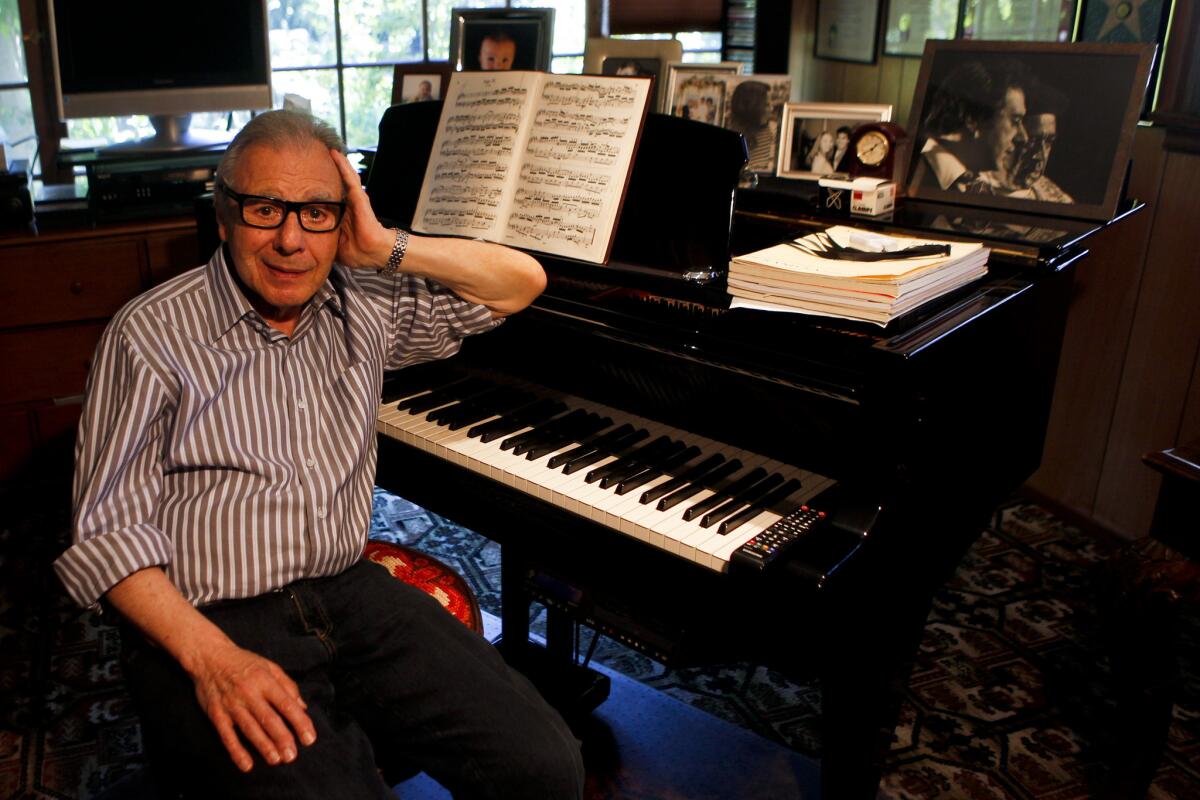Review: Pomp trumps polish at Dudamel-led Latin American music concert at Hollywood Bowl

- Share via
We’d have to dig into the Hollywood Bowl archives to find a summer that began as fruitfully as this year’s has. Gustavo Dudamel’s performances of “West Side Story,” “Rhapsody in Blue” and “Scheherazade” warrant legacy status, so naturally hopes ran high with his return this week for an Argentina-themed tango Tuesday planned as a big Bowl deal.
Dudamel built the Los Angeles Philharmonic program around Astor Piazzolla, who made the moribund tango spectacularly new. Sandwiched between the tangos were a new guitar concerto by Lalo Schifrin — the Argentine composer best known for his Hollywood work (“Mission Impossible”) and a friend and colleague of Piazzolla — along with the Four Dances from the ballet “Estancia” by Alberto Ginastera, who was the standard bearer of 20th century Argentine music and a mentor of Piazzolla.
There was more. The Argentine dance troupe Tango Buenos Aires was on hand. Because the concert was filmed by C Major Entertainment for home video release next year and also international television distribution, including on PBS, the usual video cameras and microphones on stage were multiplied. A large crane with a camera hovered over the heads of the audience on the right side of the amphitheater in seeming anticipation of something great.
The orchestra was spiffed up. Dudamel exchanged his usual black shirt for a white jacket. The video screens saturated colors so that every member of the orchestra appeared deeply tanned (L.A. presumably has a reputation to maintain) and the usual 50 shades of white of the musicians’ jackets and tops all came out looking of pure new snow.
The sound system was transformed as well, mixing the orchestra so it would sound like it might on a multichannel Hollywood soundtrack. The result was a sound stage unnaturally wide and unreal, highlighting solo instruments and instrumental sections.
Little seemed ready.
Least ready was Schifrin’s “Concierto de la Amistad,” his “Concerto of Friendship” for Angel Romero. This is the second concerto Schifrin has written for the Spanish guitarist. The first had its premiere at the Bowl in 1984. This was also — and I think this may be a record — Schifrin’s third major Los Angeles Philharmonic premiere at the Bowl.
The first, given exactly 49 years and one day before the new concerto, was a doozy — a 40-minute dramatic cantata based on William L. Shirer’s “The Rise and Fall of the Third Reich” that boldly turned the Bowl into the Nuremberg Sportpalast with a recording of Adolf Hitler screeching at the crowd through the loudspeakers. For the only time, aircraft was welcome to fly over the Bowl for additional verisimilitude.
No such luck this time. Helicopters raced above the Cahuenga Pass, no doubt giving the video producers grief. Rather than an overconfidently produced demagoguery, we watched too-vivid color close-ups of players who were maybe two (maybe more) rehearsals away from a polished premiere. Everyone looked intently at their scores. There was little sense of flow.
There was, however, lilt. The new concerto is Schifrin’s take on guitar music through the centuries — a little Baroque here, a little tango there, some Joaquín Rodrigo (Romero practically owns the “Concierto de Aranjuez”), some traces of mid-20th century Modernism (in the early ’50s, Schifrin went from Messiaen classes in Paris to Xavier Cugat’s band without missing a beat). The highlights were the lyrical solos for Romero, allowing his beautiful tone to peal across the acres, very much larger than life over the loudspeakers.
But one thing did not lead to another. No one — not Romero, not Dudamel, not the orchestra — seemed to have the feel for the score. Their attention was still on the notes on the page. A Bowl premiere is a rare and valuable thing, but the tight rehearsal schedule asks for audience indulgence. Both the cantata and the earlier cello concerto were, sensibly, recorded later in the studio.
A strange stiffness infected Dudamel’s Piazzolla as well. In the 15-minute orchestra piece, “Tangazo,” an alluring dark portrait of the seedier side of Buenos Aires, Piazzolla’s remarkable orchestral effects — strings swooping to reach pitches and winds wheezing — were often buried in a sonic mix that may, or most likely may not, have reflected Dudamel’s balances.
That was also a problem in four of Piazzolla’s most popular tangos, for which Seth Asarnow was soloist on bandoneón, the accordion-like instrument that Piazzolla played. The solo rarely stood out. Then again the music of these haunting tangos, meant for listening, rarely stood out. Rather they served to accompany the impressively acrobatic but tritely Las Vegas-y Tango Buenos Aires dancers.
Ginastera’s dances were the one bit of authenticity. These, and especially the last, “Malambo,” have long been used to showcase Dudamel’s Simón Bolívar Symphony Orchestra of Venezuela. The L.A. Phil made them live.
Here, at least, audiences watching this at home, seeing what Dudamel and the L.A. Phil are capable of, will have cause to ask Argentina to cry for them and not the other way around.
More to Read
The biggest entertainment stories
Get our big stories about Hollywood, film, television, music, arts, culture and more right in your inbox as soon as they publish.
You may occasionally receive promotional content from the Los Angeles Times.











